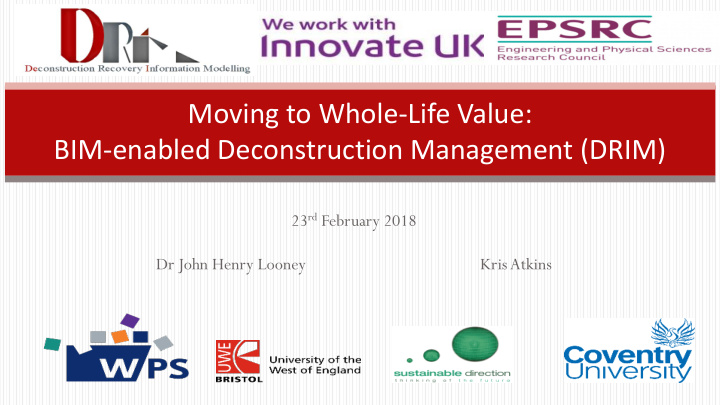



Moving to Whole-Life Value: BIM-enabled Deconstruction Management (DRIM) 23 rd February 2018 Dr John Henry Looney Kris Atkins
Sustainable Direction: Sustainability Consultancy Environmental Engineering Project Delivery www.sustainabledirection.com
Our cross cutting areas Energy Water Resource Efficiency Supply chains www.sustainabledirection.com
Circular Thinking • The demolition industry is a key contributor in the drive to increase the recovery, reuse and recycling of building materials • The industry is on the front line of progress towards a Circular Economy
Building “deconstruction” rather than demolition Pre-deconstruction audits Continual Materials to be won Improvement identified- BoQ across the industry: Segregation, storage and processing of materials included in project program/ logistics plan
• This approach maximizes material reuse and recovery as far as possible on every project • This helps ensure that value is retained and quality assured when the material enters the marketplace for reuse or recycling
Importance of BIM • BIM now mandated for all government contracts • BIM adoption increased from 13% in 2010 to 54% in 2015 • Level 2 programme a significant part of recorded savings of £840M for 2015 construction spend • Level 3 is coming
Deco construction, R Reco cove very Inform ormation on M Modelling g (DRI DRIM) • Innovate funded project, due to conclude with commercial launch in April 2018 • A BIM-compatible software tool • Provides modelling and forecasting capabilities to help developers, contractors, designers and asset owners to better understand the retained value of materials within a building • The DRIM tool is targeted at both new-build and existing building refurb/ demolition projects
BIM Plug-in • Integrated with the Autodesk Revit platform • Provides support to architects and design engineers to adopt a Design for Deconstruction (DfD) approach • Enables integration of material information and properties within a design model • Material recoverability is ensured through design, material choice and integration decisions made at design stage
Simulation Platform • Provides visualisation to support planning of the building deconstruction process • E.G deconstruction methodology, scheduling and space/ logistical considerations • Also supports whole-life performance analysis of the building to determine the best time to refurbish, rebuild or relocate a building.
• Produce a deconstruction plan • Model and simulate the deconstruction process At the Deconstruct ction s stage • Improve deconstruction protocols and the DRIM Tool will: scheduling • Improve waste collection schemes • Generate pre-demolition/ refurb material recovery estimates • Capture and predict the end-of-life properties and value of materials
Ho However er… Many barriers to material recovery cannot be overcome at demolition stage! • Materials specification- materials available are non-recyclable or contain non- recyclable components • e.g. Steel roof panels with sprayed insulation- too complex to process for recycling or have hazardous properties • Building design- building design features can often inhibit deconstruction • e.g. Make deconstruction unsafe or not economically feasible DRIM can help!
• Support architects, designers and material specifiers to design for deconstruction • Enable design decisions and material At the Design s sta tage specification to make the job of deconstruction more efficient at the the DRIM Tool will: end of asset life • Allow different material choices, fixing types, building design and material integration features to be modelled, and different options to be evaluated in terms of material recoverability and value
We need you! • We are now nearing the end of the project and are very keen to recruit volunteers to work with us and test the tool on real life projects! • If you or your organisation can assist us with this, free of charge, please contact us
Thank You Dr John Henry Looney jh.looney@sustainabledirection.com 07817 809018 Kris Atkins k.atkins@sustainabledirection.com 07711 887715 www.sustainabledirection.com @SDirectionL 01452 382218 www.sustainabledirection.com
Recommend
More recommend